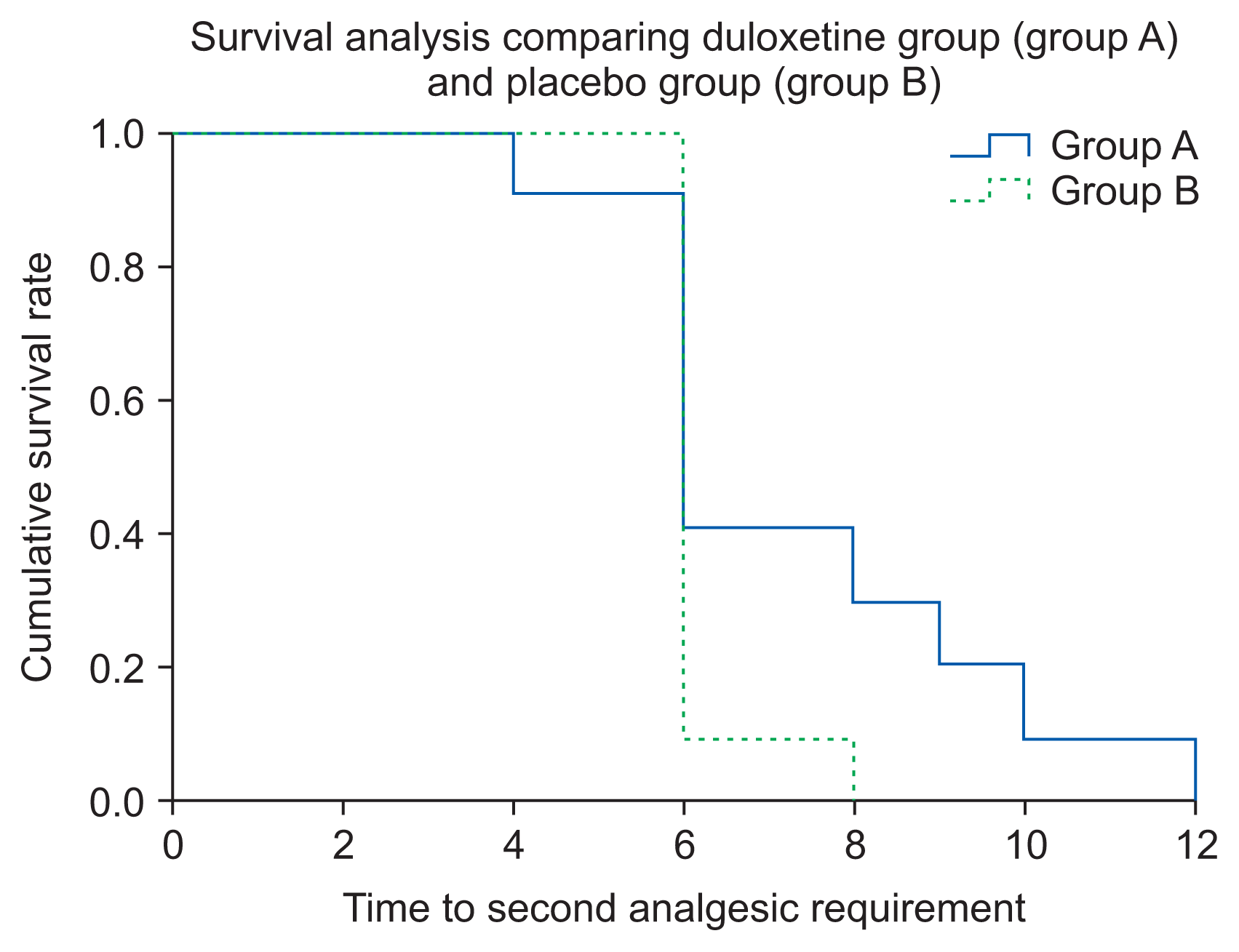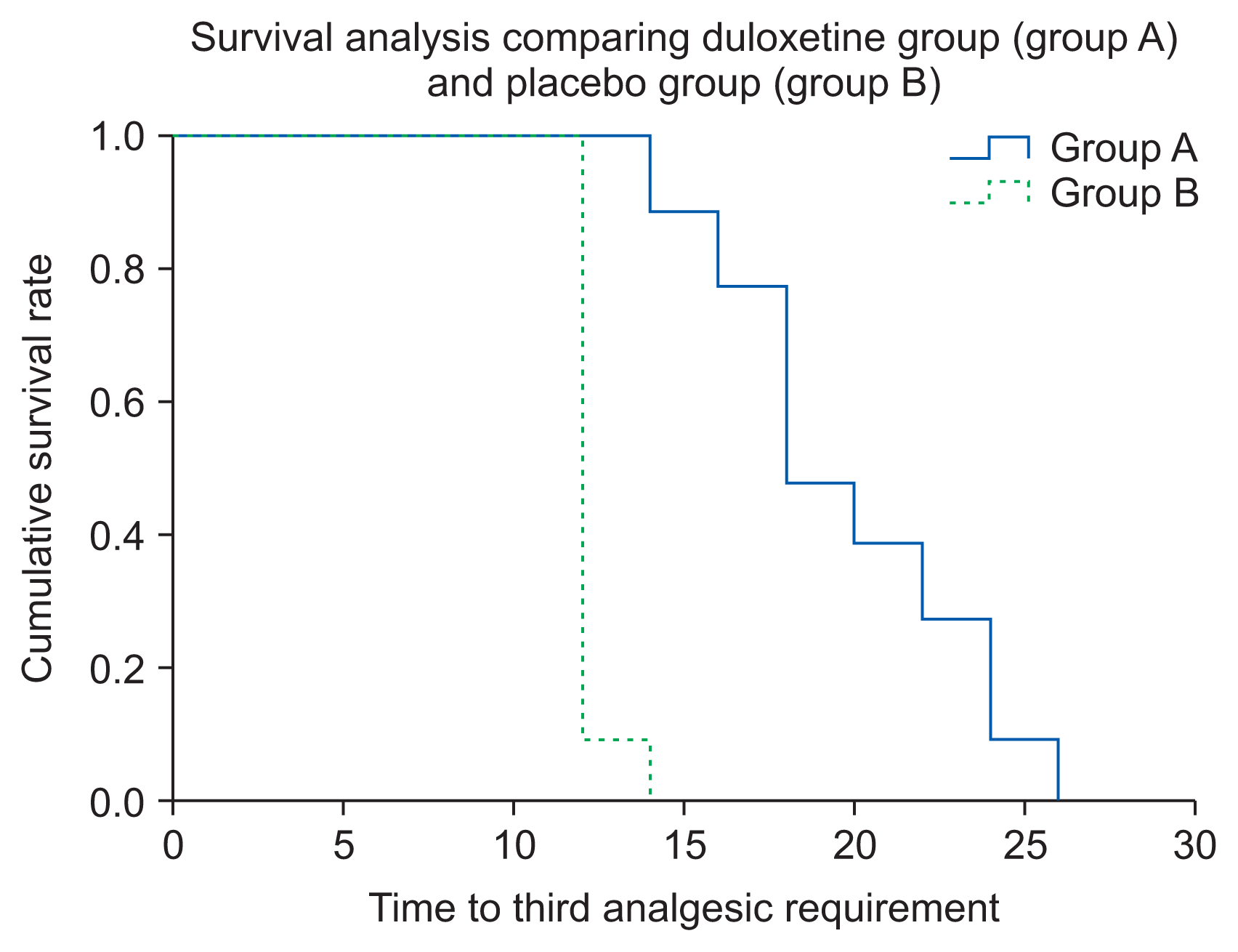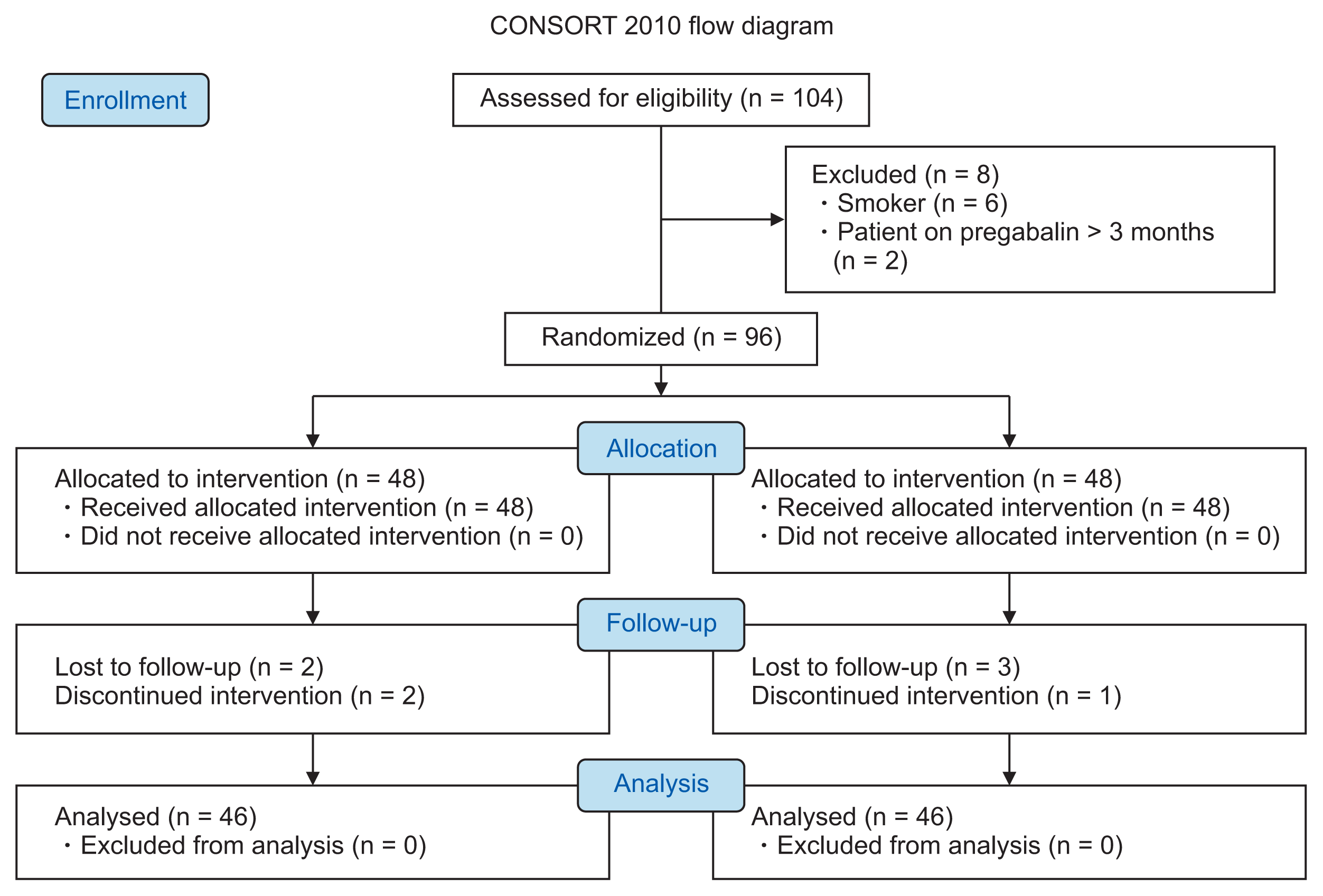1. Bajwa SJ, Haldar R. Pain management following spinal surgeries: an appraisal of the available options. J Craniovertebr Junction Spine. 2015; 6:105–10. DOI:
10.4103/0974-8237.161589. PMID:
26288544. PMCID:
4530508.

3. Vilar S, Castillo JM, Munuera Martínez PV, Reina M, Pabón M. Therapeutic alternatives in painful diabetic neuropathy: a meta-analysis of randomized controlled trials. Korean J Pain. 2018; 31:253–60. DOI:
10.3344/kjp.2018.31.4.253. PMID:
30310550. PMCID:
6177536.

4. Turan A, Karamanlioğlu B, Memiş D, Hamamcioglu MK, Tükenmez B, Pamukçu Z, et al. Analgesic effects of gabapentin after spinal surgery. Anesthesiology. 2004; 100:935–8. DOI:
10.1097/00000542-200404000-00025. PMID:
15087630.

5. Onuţu AH. Duloxetine, an antidepressant with analgesic properties - a preliminary analysis. Rom J Anaesth Intensive Care. 2015; 22:123–8. PMID:
28913467. PMCID:
5505372.
6. Sun YH, Li HS, Zhu C, Hu W, Yang J, Zhao GL, et al. The analgesia effect of duloxetine on post-operative pain via intrathecal or intraperitoneal administration. Neurosci Lett. 2014; 568:6–11. DOI:
10.1016/j.neulet.2014.03.046. PMID:
24686187.

7. Schukro RP, Oehmke MJ, Geroldinger A, Heinze G, Kress HG, Pramhas S. Efficacy of duloxetine in chronic low back pain with a neuropathic component: a randomized, double-blind, placebo-controlled crossover trial. Anesthesiology. 2016; 124:150–8. DOI:
10.1097/ALN.0000000000000902. PMID:
26517858.
8. Castro-Alves LJ, de Medeiros ACPO, Neves SP, de Albuquerque CLC, Modolo NS, De Azevedo VL, et al. Perioperative duloxetine to improve postoperative recovery after abdominal hysterectomy. Surv Anesthesiol. 2016; 60:171–2. DOI:
10.1097/01.sa.0000484604.50302.bf.

9. Gilron I. Antidepressant drugs for postsurgical pain: current status and future directions. Drugs. 2016; 76:159–67. DOI:
10.1007/s40265-015-0517-4. PMID:
26732724.

10. Ho KY, Tay W, Yeo MC, Liu H, Yeo SJ, Chia SL, et al. Duloxetine reduces morphine requirements after knee replacement surgery. Br J Anaesth. 2010; 105:371–6. DOI:
10.1093/bja/aeq158. PMID:
20573635.

11. YaDeau JT, Brummett CM, Mayman DJ, Lin Y, Goytizolo EA, Padgett DE, et al. Duloxetine and subacute pain after knee arthroplasty when added to a multimodal analgesic regimen: a randomized, placebo-controlled, triple-blinded trial. Anesthesiology. 2016; 125:561–72. DOI:
10.1097/ALN.0000000000001228. PMID:
27387351.
12. Jacobs MB, Cohen SP. Duloxetine for subacute pain management after total knee arthroplasty: should we write it off or reevaluate? Anesthesiology. 2016; 125:454–6. DOI:
10.1097/ALN.0000000000001229. PMID:
27387352.
13. Smith EM, Pang H, Cirrincione C, Fleishman S, Paskett ED, Ahles T, et al. Alliance for Clinical Trials in Oncology. Effect of duloxetine on pain, function, and quality of life among patients with chemotherapy-induced painful peripheral neuropathy: a randomized clinical trial. JAMA. 2013; 309:1359–67. DOI:
10.1001/jama.2013.2813. PMID:
23549581. PMCID:
3912515.

14. Castro-Alves LJ, Oliveira de Medeiros AC, Neves SP, Carneiro de Albuquerque CL, Modolo NS, De Azevedo VL, et al. Perioperative duloxetine to improve postoperative recovery after abdominal hysterectomy: a prospective, randomized, double-blinded, placebo-controlled study. Anesth Analg. 2016; 122:98–104. DOI:
10.1213/ANE.0000000000000971. PMID:
26421810.

15. Minami K, Tamano R, Kasai E, Oyama H, Hasegawa M, Shinohara S, et al. Effects of duloxetine on pain and walking distance in neuropathic pain models via modulation of the spinal monoamine system. Eur J Pain. 2018; 22:355–69. DOI:
10.1002/ejp.1125. PMID:
28952182.

16. Altiparmak B, Güzel Ç, Gümüş Demirbilek S. Comparison of preoperative administration of pregabalin and duloxetine on cognitive functions and pain management after spinal surgery: a randomized, double-blind, placebo-controlled study. Clin J Pain. 2018; 34:1114–20. DOI:
10.1097/AJP.0000000000000640. PMID:
30020088.
17. Kiso T, Moriyama A, Furutani M, Matsuda R, Funatsu Y. Effects of pregabalin and duloxetine on neurotransmitters in the dorsal horn of the spinal cord in a rat model of fibromyalgia. Eur J Pharmacol. 2018; 827:117–24. DOI:
10.1016/j.ejphar.2018.03.011. PMID:
29530591.

18. Shen F, Tsuruda PR, Smith JA, Obedencio GP, Martin WJ. Relative contributions of norepinephrine and serotonin transporters to antinociceptive synergy between monoamine reuptake inhibitors and morphine in the rat formalin model. PLoS One. 2013; 8:e74891. DOI:
10.1371/journal.pone.0074891. PMID:
24098676. PMCID:
3787017.







 PDF
PDF Citation
Citation Print
Print



 XML Download
XML Download